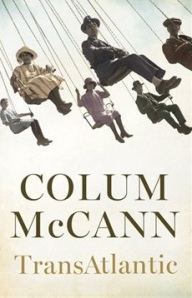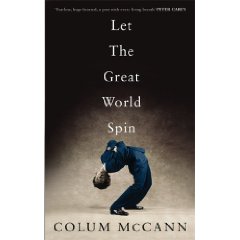So it is no surprise to see TransAtlantic by Colum McCann on the 2013 Booker longlist. He himself is part of the contemporary diaspora, born and raised in Ireland, now living in New York City. This version, however, comes with a distinct twist. In Book One of the three part novel, McCann turns the premise around, developing three story threads based on “returns” to Ireland, all featuring non-Irish central characters. While the three threads span 150 years, the author does not present them chronologically and I will respect that here:
 All three of those threads feature real-life individuals who emerge as heroes in real-life events — McCann wants to make it clear that Ireland does not just send people to North America but that at least parts of Ireland’s history are reflected in the outcome of “return voyages”.
All three of those threads feature real-life individuals who emerge as heroes in real-life events — McCann wants to make it clear that Ireland does not just send people to North America but that at least parts of Ireland’s history are reflected in the outcome of “return voyages”.
In Book Two, however, the author returns to the traditional flow, as he begins to weave his three strands together. While those opening parts outlined “global” stories based on individuals known to this day, the central characters in this section are ordinary, very Irish, individuals, all of whom were introduced as minor accessories in the first third of the book.
The most important is Lily, whom Douglass first met as an indentured maid in the house of his Dublin publisher. She later showed up at the Cork house where he was staying: inspired by his speeches, she has “escaped” servitude and is on her way to America. We pick up her story a couple of decades later in “Icehouse”; she is married to an American who harvests ice in northern Missouri in the winter and prospers by hauling it to St. Louis in the warmer months.
In the Alcock/Brown thread, McCann also introduced a Newfoundland reporter, Emily Ehrlich, and her photographer daughter, Lottie, who are covering the departure (“Alcock and Brown have been warned to be on their guard, since the mother and daughter have, by all accounts, a tendency towards nostalgia and firey Irish tempers.”) Despite that warning, Brown has developed a respect for Emily. In fact, on the morning of the departure, she hands him a packet of sandwiches and a sealed envelope to carry on the “first airmail” journey, a bit of “illegal” commerce in the enterprise. In this later section, we follow Emily and Lottie on their first trip to Europe, a six-month magazine assignment that starts with a first-class ocean liner trip and ends with a visit to the aging, alcoholic Brown in Wales.
Daughter Lottie is also the central character in the third thread of Book Two — now a grandmother she is teaching her grandson tennis at the same Belfast club where Sen. Mitchell relaxes in stolen moments from the peace negotiation process.
Having updated and braided his threads together in Book Two, McCann moves to 2011 in Book Three (“The Garden of Remembrance”) to bring all the stories into the present day. I won’t try to describe this section here beyond saying I found it the weakest part of the novel — while sympathetic, interesting characters were the strength of the first two books, in this one tidying up story lines seems to take precedence. Alas, that seems to be an issue that most authors of “widescreen” novels have to face.
I like to provide excerpts from books I review so visitors here get at least a sense of the author’s style. Unfortunately, McCann’s prose approach makes that hard to do — I noticed the same thing in the only other McCann that I have read, the multi-prize-winning Let The Great World Spin. Still, I’ll give it a go. Here’s an example of his detached, almost formal, approach to story narration, in this case Emily and Lottie watching Alcock and Brown’s Vimy as it leaves St. John’s:
She stands with her daughter at the third-floor window, hands on the wooden frame. They are sure at first that it is an illusion, a bird in the foreground. But then she hears the faint report of the engines, and they both know they have missed the moment — no photograph either — yet there is also a strange exaltation about seeing it from a distance, the plane disappearing into the east, silver, not gray, framed by the lens of a hotel window. This is a human victory over war, the triumph of endurance over memory.
Out there, the blue sky lies cloudless and uninterrupted. Emily likes the sound of the ink rising into her fountain pen, the noise of its body being screwed shut. Two men are flying nonstop across the Atlantic to arrive with a sack of mail, a small white linen bag with 197 letters, specially stamped, and if they make it, it will be the first aerial mail to cross from the New World to the Old. A brand-new thought: Transatlantic airmail. She tests the phrase, scratching it out on the paper, over and over, transatlantic, trans atlas, trans antic. The distance finally broken.
Description, by contrast, is almost stream of consciousness. This excerpt follows immediately from the passage quoted above:
Floating icebergs below. The roughly furrowed sea. They know there will be no turning back. It is all mathematics now. To convert the fuel into time and distance. To set the throttle for the optimum burn. To know the angles and the edges, and the spaces in between.
Brown wipes the moisture from his goggles, reaches into the wooden compartment behind his head, grabs the sandwiches, unwraps the waxed paper. He passes one to Alcock who keeps one gloved hand on the yoke. It is one of the many things that brings a smile to Alcock’s lips: how extraordinary it is to be munching on a ham-and-butter sandwich put together by a young woman in a St. John’s hotel more than a thousand feet below. The sandwich is made more delicious by how far they have already come. Wheat bread, fresh ham, a light mustard mixed in with the butter.
Despite the awards, Let The Great World Spin provoked a mixed response from readers and I am sure Transatlantic will as well. On the one hand, McCann likes the “grand” — a grand city in the former case, grand global events in this one. But his real passion in both books is ordinary people and the way they form part of that “grand” scheme — if that scheme represents the impressive oak tree towering above the ground (more than 150 years old in this novel), those characters are part of the essential ball of roots that sustains and grows it.
Some readers (that includes me) take to that approach while others find it frustrating. For me, McCann’s characters — both the grand and not-so-grand ones — are multi-dimensional, their stories both comprehensive and interesting. And I fully support the concept that the tallest, broadest tree needs roots that we don’t ordinarily see but should appreciate. There may be a bookcase full of previous Irish/North American novels but space deserves to be made for this one as well.

 I approached Let The Great World Spin with considerable trepidation. The tragedy of 9/11 and the destruction of the World Trade Center towers has led a number of very good writers (John Updike and Don Delillo come to mind) to write books that I found to be sorely wanting, to the point of being better left unpublished. There has also been what I would call a WTC “echo” phenomenon — works that feature the 1974 tightrope walk between the towers by Philippe Petit. For example, Man on Wire, a documentary based on Petit’s 2002 book, To Reach The Clouds, won this year’s Academy Award for documentary, after winning several festival prizes.
I approached Let The Great World Spin with considerable trepidation. The tragedy of 9/11 and the destruction of the World Trade Center towers has led a number of very good writers (John Updike and Don Delillo come to mind) to write books that I found to be sorely wanting, to the point of being better left unpublished. There has also been what I would call a WTC “echo” phenomenon — works that feature the 1974 tightrope walk between the towers by Philippe Petit. For example, Man on Wire, a documentary based on Petit’s 2002 book, To Reach The Clouds, won this year’s Academy Award for documentary, after winning several festival prizes.